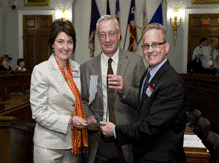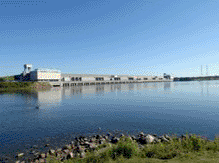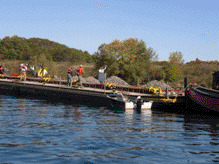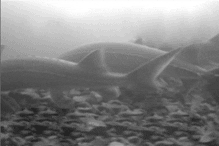Lake Sturgeon Spawning Beds

The NYPA receives the OSAW award at NHA’s Capital Hill reception on May 11, 2009.
Summary
In the late 1990s the New York Power Authority (NYPA) embarked on what was to become one of largest and most successful collaborative relicensing processes ever attempted at its St. Lawrence-FDR hydroelectric project. As part of its relicensing collaborative, NYPA is constructing lake sturgeon spawning beds to increase opportunities for natural reproduction.
In doing so, NYPA has broken with the typical approach of qualitatively characterizing an area and “giving it a try” by supplementing the traditional method with a detailed analytic approach that has achieved outstanding results. NYPA has built two spawning beds after a systematic site selection process that was supported by detailed study of the river characteristics and sturgeon activity. Large numbers of sturgeon were attracted to the area and high levels of successful reproduction occurred in the first season after the beds were in place. NYPA intends to continue this approach to locate additional beds in the future.

NYPA’s FDR Project in New York is the location of a new, innovative method of developing spawning beds for Lake Sturgeon. The use of a comprehensive analytical approach has yielded positive results for NYPA.
Background
The St. Lawrence-FDR Power Project relicensing provided the opportunity to try this unique restoration approach. Lake sturgeon have been present for thousands of years in the Great Lakes system. Through a variety of stresses, the population has been severely reduced to the point that it is now classified as a threatened species in New York. Sturgeon were known to be present in the vicinity of the St. Lawrence Project, and the New York Department of Environmental Conservation placed great value on expanding the existing population through natural reproduction. Improving lake sturgeon spawning opportunities was identified in NYPA’s collaborative relicensing process as an unmet need and became one of the Habitat Improvement Projects incorporated into the new license. NYPA has agreed to install a total of six sturgeon spawning beds.

A bottom opening hopper barge proved to be an effective means of distributing bed material evenly and precisely in select areas where spawning was observed.
Challenge
NYPA personnel encountered a number of obstacles when developing the spawning beds for long-term success. One obstacle was the need to understand water flow velocities in the areas being considered for the new beds. Sufficient flow is essential to provide water circulation around the eggs and to keep the spawning bed free of siltation and clogging vegetation. Data on flows, particularly at the level of detail needed for these purposes, was not available.
In addition, the depth of the spawning bed is an important characteristic, yet data on this matter was conflicting. Previous studies in the literature showed a high preference in other sturgeon populations to spawn at shallower depths than what had been observed in the area under consideration. However, research on the Detroit River, also in the Great Lakes system, had determined that lake sturgeon can successfully spawn in deeper waters.
Finally, the need for the new spawning bed to be placed in an area of high current velocity complicated the implementation of the spawning material on the river bed.

Lake Sturgeon swim across spawning beds placed on the bottom of the St. Lawrence River. Lake Sturgeon are a threatened species in New York, and the spawning beds are designed to increase the population.
Innovation
NYPA began the spawning bed construction process by conducting a comprehensive survey of the project impoundment – Lake St. Lawrence – using underwater videography and gill netting to determine where sturgeon were active during the spawning season.
To understand the water flow velocities in the areas considered for the new beds, NYPA initiated a study using an acoustic Doppler current profiler that produced high quality data on flow rates throughout the water column and with great detail near the bottom. With this information, NYPA was able to optimize the locations that had suitable depth and form and the most beneficial flow characteristics.
Working with a contractor, NYPA identified a bottom opening hopper barge as the most practical means of placing the bed material evenly and precisely in the identified areas. By using GPS equipment to locate the sites, it was possible to deposit multiple loads of the material to ensure that it was well distributed in the area selected.
Results
In spring 2008, NYPA conducted video monitoring, and sturgeon were observed on and near the beds. Continued monitoring showed that their numbers increased gradually at first and then dramatically. This sharp peak was believed to be the result of the dynamic of males gathering slowly and the females arriving quickly as conditions became optimal for spawning. After the sturgeon were observed, NYPA staff placed egg traps to see if spawning was occurring. Following an appropriate incubation period, drift nets were put out to indicate if larvae had successfully hatched. Production levels approached those found at very productive natural spawning beds. The beds had become an unqualified success in their first year of use.
Stakeholder Quotes
“The project team successfully utilized traditional low tech field techniques coupled with high tech Doppler profiling to bring all the necessary information components together. Collaboration and guidance from the Technical Advisory Committee was well received and aided in project design. Engineering challenges were overcome by hiring competent and experienced marine contractors. The end result was the implementation of an outstanding project which will hopefully be productive for years to come.
“To date the lake sturgeon spawning beds have been extremely successful and show great promise for the future of this species in the St. Lawrence River. Hard work, dedication, and the willingness for collaboration from NYPA’s environmental staff has led to a project that will likely be modeled by other State and Federal agencies in the future.” — Rodger Klindt, Aquatic Biologist, New York Department of Environmental Conservation


